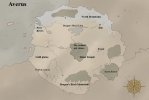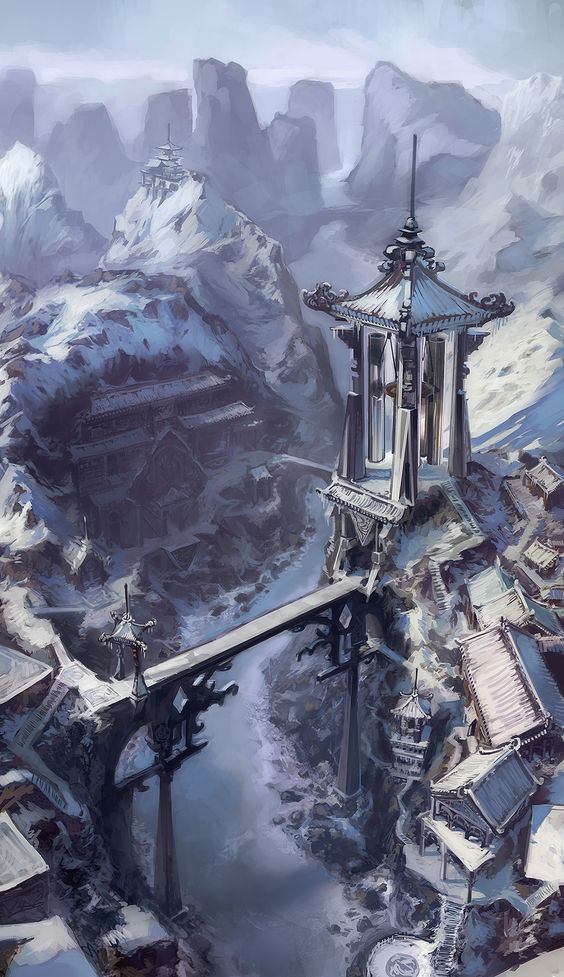Note there are many points blank on the map, those are towns and villages you can name and create lore around to suit your characters. Simply pm me to discuss and I will add approved content to the lore.
Averus is a land of lush forests, rolling plains and spiny mountain ranges. The climate is temperate, with the Northlands covered in snow for six months of the year, and the south barely seeing frost. There are many small towns and villages peppered throughout the landscape, most farming is done to the south, where fertile soil and many rivers create a patchwork at the base of the Dragon’s Back. To the north people rely more on hunting and fishing and animal husbandry, farming only hardy roots and grains where possible.
The Divine Wood
The most notable feature in the entire land is the central forest, not for its size, but for its magic. The home of the gods is home to strange and magical beasts and a myriad of different spirits too. Even the usurper’s people, who boldly trespass anywhere else, will not risk entering that forest unless in great need.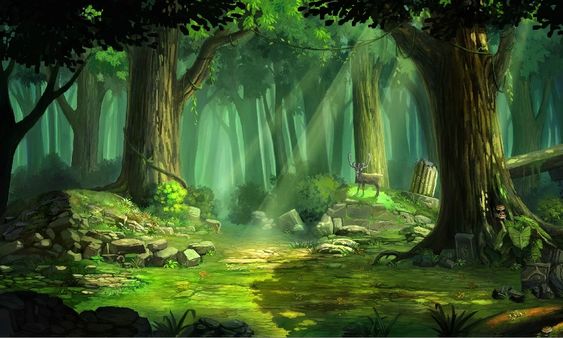
The terrain can be easy as a well-word road for those who are welcome, but the trails can double-back or vanish if the forest does not want you there. It seems the wood has a mind of its own. It is very easy to become lost among the trees, what could take days of straightforward walking, may take weeks in this forest, or hours. Many who venture there without purpose, might find themselves becoming a meal for something else.
If one knows the secrets of the wood however, it can be a peaceful and enchanting place. Flowers bloom with rainbow hues during the day, and glow like the stars at night. So many creatures exist nowhere else in the world. If you are welcome in the wood, you will always find food and shelter.
Littered among the trees and valleys are the ruins of the civilization that came before the empire. The Gods remember it, but few others do.
There are two main places of note in the divine wood: The four cardinal shrines, built as resting places for the 4 central gods, and the Rune temple, a vast temple complex to shelter and feed the many pilgrims come to ask for favour or pay homage to the gods. Now, the Rune Temple is little more than a ruin, and visited only by a brave few.
The shrines are equally-neglected, and it is here the four gods were turned to stone.
The Imperial fortress city
art by Morsasfjord
The empire has built forts and garrisons all over Averus, but their central force is always close to the Imperial fortress city of Xiir (Zeer), built in the heart of the Northeastern mountain range. From a distance you can barely make out the city spires among the jagged rocky peaks. The walls are taller than trees, pure iron and set with spikes. The gates take thirty men to open and are guarded night and day.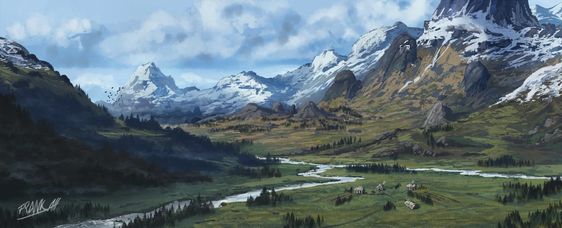
Inside the walled fortress is a snowy town. Its citizens are cold-hardy and stoic. Most of the families in the city belong to the soldiers in the usurper’s army, either the elderly too old to fight, or else the children too young. All able-bodied beings, human and deity alike sworn to the usurper’s rule, is tested for combat skill and trained.
Towns and garrisons
There are garrisons in all of the major towns in the Northern half of Averus. These are under Imperial control. Each garrison is headed by a prominent captain or general in the usurper’s army, and they often double as the leader of the town. To the South, the military influence is considerably less, oftentimes only the governing body of a town will be Imperium, and have a handful of soldiers at their command.
The old ways
Most of the clothing, tools and culture is Imperial now, but there are still a lot of local customs and clothing that remain. It is diverse and different for each region. One hundred years ago, the land was divided by cardinal direction and each direction favoured one of the four gods. South favoured the deity of earth and nature, North, the deity of air, East, the deity of fire and West the deity of water. The old gods are still more favoured in their designated regions, at least, for those who still remember them.
Many regions still hold traditional festivals, like the right of spring, overseen by the earth deity.
((The other 3 central deity players and others can help me make up more festivals and holidays))
The empire
The empire has one rule: if you can serve as a soldier, you serve, human, spirit or god. The emperor rewards skill with high position and protection for friends or families. Most of the resources used by the empire come from the nearby farmland, levied from those living there as tax. The same system is used for the garrisons stationed in most major towns. In the South the empire has a looser grip, though they are still present. The governing of local areas is left mostly to the local authority and it is up to them how much they wish to oppress the people and culture. As long as the empire gets resources and soldiers, it tends not to care.
Gods
All gods are fairly sturdy, and only serious wounds take time (about a single night with an offering or sacrifice) to heal up. Most smaller wounds take minutes to hours depending on the severity. Not all gods can transfer their healing to others. It must be a focal skill of theirs. Killing a god is a very difficult task, but it can be done if the wounds are severe enough, or the god has traded enough of their essence to a specific magical power or task. Most gods understand a balance is in place in the world, and wanton killing is ultimately detrimental. The old gods are prevented from taking lives except in the greatest need, and the usurper clan gods are under strict instructions to limit killing to tactical advantage, though this rule isn’t well-enforced. The central difference between gods from Averus and gods from the usurper clan are the secrets they hold. Usurper clan gods and only they have the secret to killing without becoming a demon. this is how they receive sacrifices.
Both god clans are similar in most other regards. They have the same weaknesses based on their powers, and they both bleed golden ichor.
The old gods
Art by Matt Stewart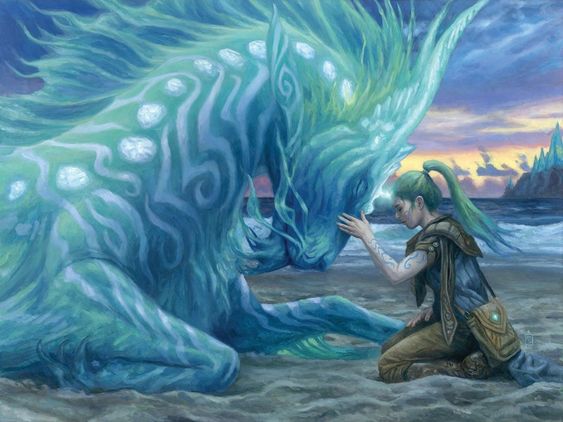
Though there are four central deities, most well-known and celebrated. They were once humble spirits, like the grand diversity that exist to this day. Some of these spirits have become minor gods, having a set village or peoples that worship them, but ultimately, god or spirit, the origin is the same.
Each spirit is possessed of a power, which can grow stronger with the faith and offerings of mortals.
Oftentimes, this magic power is elemental, though that is not always the case. The old gods of Averus rely on gifts freely given to increase their power. Nothing can be taken by force. To steal or kill without just cause is to defy the law of the very land, and it can have dark consequences. Also, gods cannot give offerings to other gods to increase their power.
The usurper gods
The original usurper and his generals came from a land far away. They do not often have animal forms and remain mostly human. These gods relied on sacrifice to win the war, and they still do, passing on this tradition to others as they live. If you are a deity or spirit serving in the empire it is very difficult to avoid taking a sacrifice, though it can be done if one is clever. Though their power is consolidated in blood, there is a very strict protocol: The sacrifice can be anything, destroyed in the name of the deity or spirit, it does not have to be living, though living things offer the most power. The deity cannot be the one to destroy it, it must be destroyed, or else the life must be taken by a mortal follower of the god. The life taken does not have to be willing. The other catch about this way of maintaining power? It wears off. Gods from the usurper’s clan require sacrifices regularly or they become weaker, losing powers in a matter of days or weeks. Generally, the garrisons have the means to maintain their gods’ powers, but long treks into territory not completely dominated by the empire are always risky.
There is a theory as to why the usurper was stronger than the old gods of Averus, and that is this: a god or spirit can be sacrificed for an immense amount of power. This of course, the emperor has made taboo, to avoid underlings gaining too much power, and it is very difficult, as a mortal must be the one to make the sacrifice, and generally they cannot hold a candle to the power of a spirit or god and so cannot hope to kill one unaided.
Demons
A spirit can be born from many things, an element, an animal, and object or a sentiment. If enough malice is poured into any one of these things, the resulting spirit can lose its conscious mind and become a destructive, chaotic thing. These corrupted spirits are demons, and they roam like beasts throughout the world, preying on the weak, trying to get stronger. They have no reason, and no speech. They can take nearly any form, and some of them are very large. Their powers and forms are as varied as the gods and spirits of Averus, and since the coming of the usurper, there have been many more of them. Wards and charms generally keep them away from human villages, and most conscious spirits are too strong for a single demon to attack directly. Still, they have power and should not be taken lightly.
The true danger with demons however, is that enough acts of evil from a conscious spirit or god can bring about this madness and turn them into demons. This is what the old gods thought would happen to the usurper and his minions when they first invaded, but something in their possession kept the madness at bay. To this day the old gods and spirits have not found out what this secret is, why the usurper clan has not gone mad with all the evil they have done. It is known only to the usurper and his closest allies.
God powers can be almost anything imaginable. First, the powers will be fairly weak, but there will be a list of about 6 central powers you can have in your CS, and at the start, only 2 will be usable, the rest will be greyed out and be added as the story progresses. The humans with powers will have 1 to start, and you don’t have to have a complete list either, you can add things to that list as the rp progresses. I will decide with the player when they should activate the rest of their powers based on events in the story.
Usurper gods will also have their powers diminished, as they will be traveling in the Divine Wood without the means to replenish their power, so everyone starts on the same level.
Offerings
An offering can be made in many different ways, and different offerings can have varied effects: The power contained in an offering is based on the value of the item to the one giving it: So, a poor man giving three coins to a god is worth far more than a rich man doing the same. Or something of sentimental value will have a much stronger effect that something easily parted with.
Once offered the item dissolves and the energy is absorbed by the God. You cannot retrieve an item that has been offered.
Gods have preferences as to what they like and do not like, and giving a favoured item might make them more amenable to your request, though that is up to the deity and the intentions they interpret behind the offering.
If an item that is offered has been directly stolen or acquired in a bad way, to make the offering, it can have fairly chaotic consequences. It can disrupt the god’s powers, make them sick or inhibit them in other ways. The item offered must be owned irrefutably by the one offering it to have a full effect.
Sacrifices
The most common sacrifices are not living, breathing things, but precious items, well-crafted and valuable. The next most common are animals and only the highest ranked soldiers of the usurper army get human sacrifices. It is considered a high honour (for the sacrifice), and one can change their status and provide for their families for life by volunteering for it. The rules around this process are extremely strict, and any god caught performing this particular sacrifice without authorization is put to death. The ceremony of giving offerings is thought to be much weaker in strength and is generally dismissed.
Not all gods are happy with the system, some find the sacrifices abhorrent and look to find other means to gain power, or else are content to stay humble.
What happens though, when a usurper clan god is given an offering? Well, you’ll find out.
- TBD
- TBD
Last edited:


